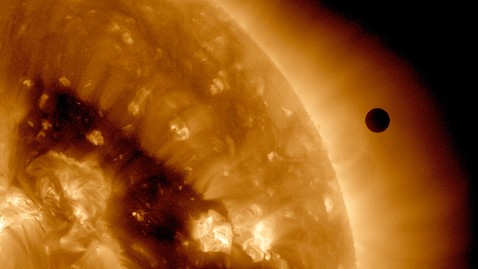Venus Transit: Beautiful Pictures and Video

Transit of Venus as seen by NASA's orbiting Solar Dynamics Observatory. NASA/SDO
It's the day after. Tuesday's transit of Venus is over, not to be repeated until Dec. 10-11, 2117, and then mostly visible from the Pacific basin and the countries of easternmost Asia.
So if you missed it, we thought we would reprise some highlights. NASA's Solar Dynamics Observatory, launched into orbit in 2010, had perhaps one of the best views, 22,000 miles above those pesky clouds that got in the way for many Americans. It shot high-resolution video in different wavelengths of light as the black disc of Venus marched across the face of the sun. It's sped up in the clip below - the actual transit took about six hours and 40 minutes - but we think you'll find the results pleasing.
Earthbound photographers were at the ready too.
Click Here for Pictures: Transit of Venus 2012 .
Just one of the images we saw:

Transit of Venus seen from the Taj Mahal, Agra, India. Kevin Frayer/AP Photo
When transits took place in past centuries - Johannes Kepler only calculated in 1627 when they would happen - moneyed amateurs traveled, some at great risk, to remote parts of the world to see what they could see. It was of more than aesthetic importance to them; knowing the orbital periods of Earth and Venus, they used the transits to calculate that Earth was 93 million miles from the sun.
Since then transits have diminished in scientific importance - but NASA did use the occasion to help another. There happens to be a spacecraft called Kepler, launched in 2009 to scan a region of space, watching for planets orbiting other stars. Its method: to see if the stars dim ever so slightly (less than a hundredth of one percent) as those distant planets transit in front of them.
How can it tell those far-away transits from, say, sunspots? Tuesday's transit provided a way for engineers to calibrate their instruments. They know the diameter of Venus and the sun, and if they could measure the infinitesimal dimming of our sun, they can better determine what Kepler is seeing happen to other suns.